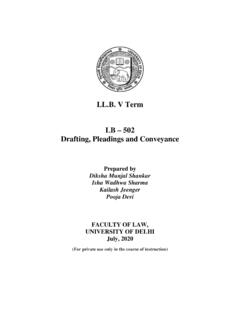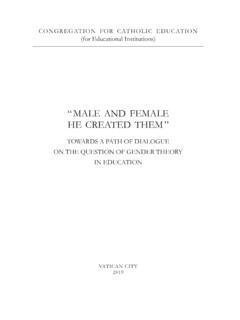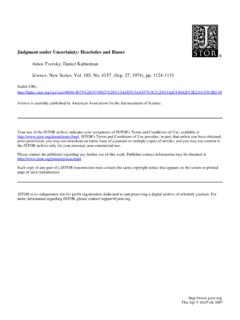Transcription of Breaking the Cycle of Racism in the Classroom
1 Rita Kohli177 Teacher Education Quarterly, Fall 2008 Breaking the Cycleof Racism in the Classroom :Critical Race Reflectionsfrom Future Teachers of ColorBy Rita Kohli As a resource specialist in a middle school in Oakland, California, I worked with many students who were labeled learning disabled. Contrary to the label, these students were critical of the world and challenged it in brilliant ways that have forever changed my life perspective. My first year teaching I had an African American student named Eddie1; he was a talkative and confident sixth grader who struggled in math.
2 Learning how this young man saw the world pushed me, more than anyone had to that point, to reflect on cultural biases within education. Since then, I have Rita Kohli is a teacher educator and doctoral candidate in Race and Ethnic Studies of Education at the Graduate School of Education and Information Studies at the University of California, Los a lot about this subject, but I also realize how invisibly the dominant culture can penetrate the way we see ourselves and the world around us. To highlight the impact that cultural bias in schools can have on Students of Color, this article articulates themes that emerge from the personal narratives of nine Women of Color2 enrolled in an undergraduate education program in Southern California.
3 Through qualitative interviews, these future Teachers of Color reveal discriminatory experiences in their own edu-cation; as well as convey advice on how to prevent and break cycles of Racism in classrooms of today s Interrupting Racism in the Classroom178youth. The voices of Teachers of Color are often invisible from education discourse; however, this study adds a much needed perspective to teacher education, and can provide a model of pedagogical reflection that, I believe, should be replicated in programs serving prospective Teachers of Color. Whose Standards Are the Standards?
4 One day, a few months into my first school year as a teacher, I was in the hall-way during lunch talking with the English teacher, Ms. Wright. Eddie came up to us and asked, Ms. Wright, I don t got no lunch money, can I sit in your room and use the computer? Ms. Wright was a seventh year White teacher who received a lot of respect for the high academic standards that she held students to at this under-performing school. Ms. Wright immediately responded, I am not going to answer that question until you speak correctly. How can we say that in proper English? We both looked at Eddie, waiting for him to rephrase his words, but instead he calmly replied, Maybe not in your house, but in my house that is how we speak correctly.
5 Ms. Wright and I were both caught off guard and a little speechless, and Eddie just stood there un-phased, waiting for us to let him use the computer. That incident stuck in my head for the next few days. Eddie, with his direct comment, had pointed out something that I had been taking for granted as a teacher. I knew that Oakland was the center of the Ebonics debate. I was also aware that there is controversy over how to address differences that exist between the language that students come to school with and what they need to know for most colleges and professional jobs.
6 But what I was not conscious of, until Eddie so confidently pointed it out, was that although differences exist in the structure of African American Language (AAL) and Standard American English (SAE), at this school, we were actually teaching a hierarchy of those differences (Faires Conklin & Lourie, 1983).3 I began to reflect on how many classrooms I had walked into where daily oral language, an exercise for students to work on SAE grammar, involved a teacher asking a class of predominantly Black students to correct a sentence that was written in AAL. I began to think of all the times in which I had corrected students speech and writing from AAL to SAE without thinking twice.
7 Rather than teaching youth that languages and dialects have differences, and that SAE is something that we often have to know in order to access academic and economic mobility, I was teaching children that SAE was correct and AAL was incorrect. Soon after Eddie s comment in the hallway I began to read about teaching cultural differences, and my pedagogy began to reflect my newfound awareness (Perry & Delpit, 1998; Yosso, 2005). This was a huge lesson that I learned from my 11-year-old student, but I was still not settled around this issue. What I continued to struggle with was the fact that, like Eddie, SAE was not the primary language in my own home growing up.
8 My family is from India, and Hindi is the first language of my parents. In my Rita Kohli179house, my parents speak what I like to call Hinglish a fluid blend of Hindi and English. So I was perplexed: Why was someone like me, someone who comes from a non-SAE home, so quick to uphold the standards of the English language? Why did I assume that Standard English was the best way to express things? What hap-pened in my life that led me to, consciously or not, hold dominant White culture superior while teaching Youth of Color? Growing up, I lived in several cities and small towns around the country.
9 Although my parents spoke Hindi around us all the time, I could understand it but never was able to speak it. A rare privilege, in college I was able to study the language, but it was not until studying abroad in India that I finally felt fluent. When I have asked my parents why my brother and I never learned Hindi as children, one story they tell makes me reflect on how much power teachers have in reinforcing cultural hierarchies. I was born in Dayton, Ohio, in the late 1970s. At that time, our family was one of few immigrant families in this mid-western city. As my brother was beginning pre-school and I was just a baby, a teacher told my mother that she had two Per-sian children in her class the previous year that spoke Farsi.
10 Her analysis was that because their primary language was not English these children had trouble making friends and were often confused at school. This White teacher emphasized that my mom should make sure to teach her kids (my brother and I) only English, so that we would not feel excluded or confused. As a new mother and recent immigrant my mom listened to this Ohioan teacher, and she and my father began to censor their Hindi around us. Because language acquisition happens most easily at young ages (Carroll, 1999), this Ohioan teacher s advice was a large reason why I was unable to speak Hindi for most of my life.














